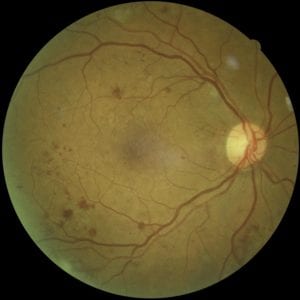 Research is under way to develop new techniques for detecting diabetic retinopathy at early onset with the hope of improving prevention and treatment of this major cause of blindness.
Research is under way to develop new techniques for detecting diabetic retinopathy at early onset with the hope of improving prevention and treatment of this major cause of blindness.
Diabetic retinopathy is a common complication of diabetes, occurring when high blood sugar levels damage the cells in the retina at the back of the eye.
The disease is the most common cause of sight loss in people of working age. It is estimated that in England every year 4,200 people are at risk of blindness caused by diabetic retinopathy, with 1,280 new cases identified annually.
As part of the Retinal Vascular Modelling, Measurement and Diagnosis (REVAMMAD) project led by the University of Lincoln, UK, Marie Curie Researcher Georgios Leontidis is investigating new methods for the early screening and diagnosis of the disease by developing computer models which can detect small changes in the blood vessels of the eye.
Funded by the European Union’s 7th Framework (FP7) Marie Curie Initial Training Network programme, the University of Lincoln has been awarded 900,000 euros from the 3.8 million euro budget to lead the project and to develop retinal imaging and measurement training and research.
It aims to improve diagnosis, prognosis and prevention of diseases such as diabetes, hypertension, stroke and coronary heart disease and retinal diseases.
All people with diabetes are at some risk of developing diabetic retinopathy, regardless of whether their condition is controlled by diet, tablets or insulin.
Diabetic retinopathy progresses with time, but may not cause symptoms until it is advanced and close to affecting the retina. The retina is a light-sensitive layer of tissue, lining the inner surface of the eye. The optics of the eye create an image of the visual world on the retina in a similar way to the film in a camera.
Diabetes affects the structure of the vessel walls, making them stiffer. At an advanced point this causes them to break, creating haemorrhages and micro aneurysms, which are the first stages of diabetic retinopathy.
Georgios, an Electronics and Computer Engineer within the University of Lincoln’s School of Computer Science, is investigating the effects of diabetes on the retina’s vessel walls and how this ultimately affects the flow of blood in the whole vasculature of the retina.
He said: “Here at the University of Lincoln, our efforts focus on analysing images of diabetic patients before the first stage of diabetic retinopathy. In that way we want to see what changes diabetes causes to the retina vessels and how these changes progress to retinopathy. We will then try to correlate the standard features we extract from these images with functional changes that occur, such as abnormality in blood pressure, blood flow volume and blood flow velocity, as well as to associate them with some risk factors like age, type of diabetes, duration of diabetes, gender and smoking.”
For more information on the REVAMMAD project, visit the project blog revammad.wordpress.com or contact Georgios Leontidis on phone +44(0)1522 886873 or e-mail gleontidis@lincoln.ac.uk